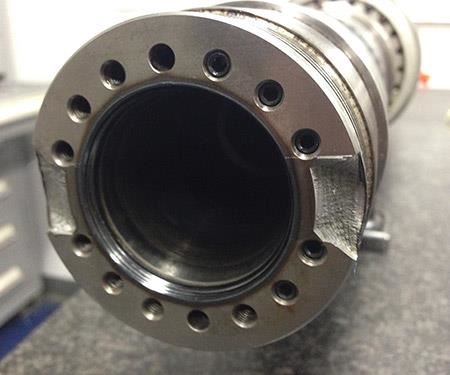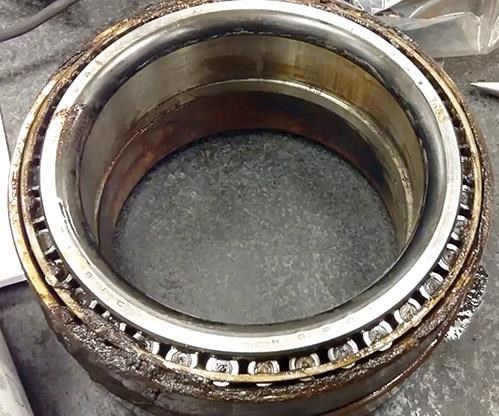Fending Off Spindle Failure
In addition to offering seminars on spindle preventative maintenance, GTI Spindle Technology also has a portable vibration analysis unit that can be operated via a tablet app.
As machine tool spindles have gotten faster and more complex, the costs associated with repairing those spindles have increased. According to Tom Hoenig, president of GTI Spindle Technology, the average cost of spindle repair is now closer to $10,000 compared to $3,500 not so many years ago.
Mr. Hoenig’s company, a preventative maintenance and spindle repair specialist headquartered in Manchester, New Hampshire, commonly offers training seminars at machining facilities that address a variety of topics related to spindles. He says that 70 percent of spindle failures result from either a crash/impact between the spindle and the workpiece or fixture, or from spindle bearing contamination.
Crashes commonly occur because of human error, he explains. This includes programming mistakes, a misaligned tool, a toolholder improperly mated with the spindle, or fixturing that has been mounted incorrectly. And while crash sensors are now available on machine tools, they tend to mitigate damage rather than prevent it from happening in the first place.
Spindle bearing contamination can occur when an operator directs an air hose at the spindle while blowing away coolant from the workpiece, fixtures other components. Mr. Hoenig says this can force particulate matter in the coolant into the spindle’s bearings. (Misdirected coolant nozzles can also cause this.) Positive-pressure “purging” seals are available to protect the interior of the spindle, but they can still be defeated by the high pressure of air or coolant streams.
In addition, the design of some high-speed spindles can make it difficult to prevent contamination. Traditional rotating components employ contact seals against contamination. In order to achieve the higher speeds that spindles require, the contact between rotating components needs to be minimized, thus excluding contact seals from use and requiring what is known as “labyrinth seals,” which can permit contamination.
Beyond crashes and spindle bearing contamination, Mr. Hoenig says the remaining 30 percent of spindle failure is caused by lack of proper spindle lubrication, failure of spindle support equipment such as chillers, and failed connections within the machine tool’s electrical system.
So how can a shop go about protecting its increasingly hefty investment in machine tool spindles? Here are a few topics that GTI addresses in a typical spindle preventative maintenance seminar:
-
Preventing contamination of machining fluids.
-
Proper spindle installation and removal.
-
Bearing impact prevention.
-
Best tooling interface approaches.
Mr. Hoenig also suggests that shops consider investing in a portable vibration analysis unit that can be operated via a tablet app. The app works with an accelerometer, which is a piezoelectric measurement device used to measure specific vibration at particular frequencies. GTI’s accelerometers are now wireless and have a magnetic base for easy mounting to the spindle.
As for the frequency of testing, Mr. Hoenig recommends using it monthly, or particularly after a spindle crash/impact, in order to determine the exact spindle condition. Conducting this exercise on a monthly basis enables the user to watch the deterioration of the spindle over time. Conversely, outside service companies can be contracted to conduct periodic testing using one of these units. Some service providers, including GTI, also can attach a permanent-mount sensor to the spindle that uploads data to the cloud, where the company can monitor it and alert the shop when data show that a spindle problem may be imminent.
Related Content
Choosing a Five-Axis Machine Tool With Automation in Mind
While much focus is placed on the machinery that moves parts, the features most important for automating five-axis machining are arguably found in the machine tool itself.
Read MoreHow to Start a Swiss Machining Department From Scratch
When Shamrock Precision needed to cut production time of its bread-and-butter parts in half, it turned to a new type of machine tool and a new CAM system. Here’s how the company succeeded, despite the newness of it all.
Read MoreChoosing The Right Grinding Wheel
Understanding grinding wheel fundamentals will help you choose the right wheel for the job.
Read MoreGrinding Wheel Safety: Respect The Maximum Speed
One potential source of serious injury in grinding comes from an oversight that is easy to make: operating the wheel in an over-speed condition.
Read MoreRead Next
3 Mistakes That Cause CNC Programs to Fail
Despite enhancements to manufacturing technology, there are still issues today that can cause programs to fail. These failures can cause lost time, scrapped parts, damaged machines and even injured operators.
Read MoreThe Cut Scene: The Finer Details of Large-Format Machining
Small details and features can have an outsized impact on large parts, such as Barbco’s collapsible utility drill head.
Read More









.jpg;maxWidth=300;quality=90)








.png;maxWidth=300;quality=90)









